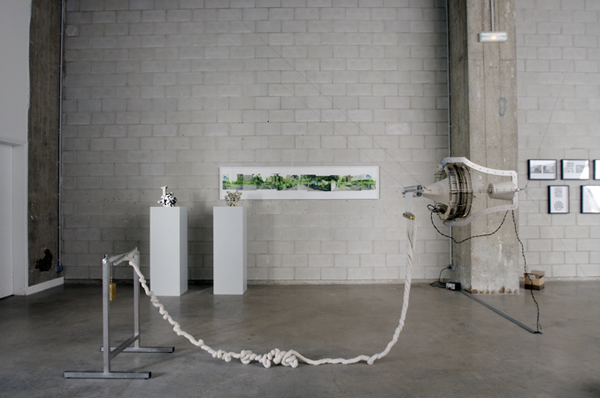Science versus fiction

- View of the exhibition "Science Versus Fiction", Bétonsalon - Center for Art and Research, Paris, 2009. Image: Aurélien Mole
Artists: Berdaguer & Péjus, Olafur Eliasson, Judith Fegerl, Ceal Floyer, Héhé, Guillaume Leblon, Vincent Mauger, Michel Paysant, Tobias Putrih, Ariel Schlesinger,
Alberto Tadiello, Luca Vitone
Scientifics: Denis Bartolo, José Bico & Benoît Roman, Benjamin Haffner &
Rémi Margerin
Curators: Mélanie Bouteloup and Hélène Meisel
Imagination is just as important in the arts as in the sciences. New discoveries, new advances in science, even from a retrospective point of view, do not follow a logical path. They raise new questions, they open up the possibility of new avenues of exploration, just as new creations in art do [1].

- View of the exhibition "Science Versus Fiction" with Vincent Mauger, Chateau Millésime, 2009. Bétonsalon - Center for Art and Research, Paris, 2009. Image: Aurélien Mole
In the ZAC Paris Rive Gauche district, as yet still a building site, the exhibition “Science versus fiction” – borrowing its title from an artwork by Tobias Putrih - will attempt to uncover and open up the relationship between architecture and scientific experiments. Somewhere between the architect and the engineer, the figures of the artist and the researcher interpose themselves, united by a taste for experimentation and DIY, both caught between the intuition of a hypothesis and its practical application. "Science versus fiction" will propose a pragmatic approach to architecture, with examination, experimentation and testing of materials. By multiplying the possibilities of interpretation, a sensitive and personal approach to architecture will be encouraged. "Science versus fiction" is looking to question the supposed innocence of artistic practices, the abstraction of scientific research and the arrogance of architectural posturing. [2] In order to do this, we will put limits to the test: by breaking the boundary that distinguishes the art object from the scientific object, by testing the physical and psychic qualities of human and architectural bodies, and by revealing the surface of materials. In this instance, "versus" in fact means bringing together rather than an opposition.
The exhibition will bring together works resulting from prospective tests and analyses (much as in psychoanalysis) but will also include the observation of several scientific experiments carried out in the laboratory: research protocols interrogating the resistance of materials or the mechanics of fluids (the circulation of drops of water put under tension, the movement of sand in the wind, the study of organic life...). By studying the molecular, the details and the incidentals, it is possible to understand the whole. Architecture is an assembly of living forms. Therefore, "Science versus fiction", by bringing to bear certain experimental protocols taken from the study of natural phenomena, could allow the possibility of a different architecture: quasi organic, reactive, more personal, even precarious and resulting from our sensitive and sentient experience of the world. Neither harmful or beneficial, this architecture would be as unstable and unpredictable as the rapidity of a chemical reaction.
Rather than thinking about "architecture for architects" born from rigorous planning, it would be a case of envisaging constructions dreamt up by end-users/amateurs, liberated from conformism and pure utilitarianism. The imagination of the passer-by could also be put to concrete, useful applications. There is no magazine of practical architecture. By putting aside the usual specialist models, posters and high-tech simulations, we are acknowledging the empirical knowledge, sensibility and considerable imagination of the individual user. The inhabitant, prey to the determinism of urbanism, reveals themselves to be actively participating in the furnishing of their own territory. According to Yona Friedman, "The power of decision legitimately belongs to the future user". [3] Therefore their psychology and their capacity to appropriate what they see will be analysed, in relation to perceiving and feeling the built environment. Psychological tests and scientific methodology will be our preferred tools. Then it will be a case of returning to less spectacular, more straight-forward and concrete preparatory plastic stages. "Experimental objects". In the public and domestic space, the artist’s studio and the scientist’s laboratory, the "cooking up" of constructions is played out, intuitive, sometimes visionary, sometimes failed, favourable to fantasies and utopias.
Urbanism conditions behaviour and generates emotions; in this respect, it is also a science of the senses. Le Corbusier wrote: "Architecture is making moving relations, using raw materials". [4] Certain architectural edifices, despite being born of utopic desires, have shown themselves to be unlivable or anxiety-inducing. The ZAC Paris-Rive Gauche district can seem cold and unwelcoming as the bird flies: right-angled, grey and cuboid. However, the exhibition has an ambition to supplant this aerial point of view with a physical, tactile approach which will once more allow the buildings to be seen as "poetry-inspiring objects", as Le Corbusier termed them.
Download the press release (only in French)
[1] Israël Rosenfield (Extract from a catalogue by Berdaguer and Pejus: "What would you say to a life supplement?”, published by: Editions du Lieu Unique in 2006)
[2] Expression partly borrowed from Jean-Pierre Rehm, in a text published in a catalogue by Berdaguer & Péjus published by Ed. HYX
in 2001.
[3] Yona Friedman, For a scientific architecture, Belfond, Paris 1971.
[4] Le Corbusier, Towards an architecture, ed. Flammarion, Paris 1995. Original edition published in 1923.
Share